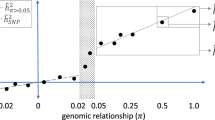Abstract
Simulation studies were conducted to assess the relative merits of different nonrandom sampling strategies for the selection of sibling pairs for genotyping in the attempt to locate individual loci (QTLs) contributing to variation in human quantitative traits. For a constant amount of variation contributed by a QTL (25% of the total) the frequencies and dominance relationships of a trait increasing allele were varied. Three strategies for selection of pairs for genotyping were based on the phenotypic values of the siblings: “Concordant sib pairs” (CSP) are pairs in which both individuals exceed a given threshold value; “discordant sib pairs” (DSP) are pairs in which one member exceeds a given upper threshold and the other is below a specified lower threshold; and “most similar pairs” (MSP) are pairs selected for falling below a specified percentile ranking of the within-pair mean square for the quantitative trait. Tests for linkage with markers at 1, 2, 5, 10, and 20 cM from each of the QTLs were conducted for each of the selected samples and compared with tests based on the regression, in the entire sample, of within pair variation on the proportion of alleles identical by descent (IBD) at each marker locus. Tests for the effect of the increasing allele at the QTL (“candidate gene”) were also conducted for the DSP pairs. No single nonrandom selection procedure yields as much as half the information realized in the total sample. However, a combined strategy which involves genotyping the 5% of MSP and DSP for the upper and lower quintiles of values of the quantitative trait (a further 3% of the sample approximately) yields lod scores which are usually more than 65% of the values realized for the entire sample. Tests comparing the proportion of increasing alleles in high- and low-scoring siblings from DSP samples are uniformly very powerful for detecting candidate loci. Even when it is not possible to measure the entire range of the phenotype with uniform precision, some attempt to differentiate among individuals in a common “unaffected” class of individuals can lead to considerable increase in power.
Similar content being viewed by others
References
Carey, G., and Wiliamson, J. A. (1991). Linkage analysis of quantitative traits: Increased power by using selected samples.Am. J. Hum. Genet. 49:786–796.
Numerical Algorithms Group (1990).NAG Fortran Library: Mark 14. Numerical Algorithms, Group, Oxford.
SAS Institutes Inc. (1988).SAS/STAT User's Guide, SAS Institute Inc., Cary, NC.
Author information
Authors and Affiliations
Rights and permissions
About this article
Cite this article
Eaves, L., Meyer, J. Locating human quantitative trait loci: Guidelines for the selection of sibling pairs for genotyping. Behav Genet 24, 443–455 (1994). https://doi.org/10.1007/BF01076180
Received:
Accepted:
Issue Date:
DOI: https://doi.org/10.1007/BF01076180




